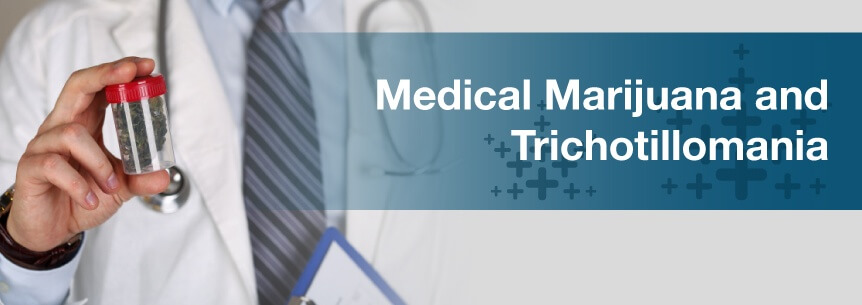
Trichotillomania is a condition characterized by compulsive behavior. Usually, doctors prescribe antidepressants and anti-anxiety medications to treat compulsive behaviors, and these come with an array of unwanted side effects. Therefore, it’s not surprising many individuals are turning to cannabis to treat behavioral conditions like obsessive-compulsive disorder and now trichotillomania. This is because medical marijuana and trichotillomania treatment can be effective at relieving the symptoms.
Trichotillomania is a mental disorder, also known as hair-pulling disorder, involving obsessive, recurrent urges to pull your hair out of your eyebrows, scalp and other body areas. The compulsion can be strong enough to make it difficult for people with this disorder to stop.
Scalp hair pulling often leads to patchy bald spots that can interfere with work or social functioning and cause significant distress. Trichotillomania patients may feel the need to go to extreme lengths to hide their hair loss.
Some individuals have generally manageable and mild trichotillomania, while others experience an overwhelming, compulsive urge to pull their hair out. Treatments have helped some individuals either decrease or completely stop their hair pulling. But, for others, the urge goes on despite significant hair loss.
Hair pulling can occur during both active and sedentary activities — sometimes in an automatic manner where the person isn’t aware of the pulling, and sometimes in a more goal-directed way. Often, people report certain distinct sensations before, during or after they begin pulling their hair out.
Various emotions can affect hair pulling as well, including:
Certain beliefs, thoughts and values can precipitate trichotillomania as well.
Even though the hair-pulling severity ranges widely, many individuals with the disorder struggle with a noticeable loss of hair and try to camouflage it desperately. They may try to cover bald or thinning spots on the head with:
Individuals who have missing body hair, eyelashes or eyebrows try to use clothing, makeup or other means to conceal the affected areas.
Because of embarrassment and shame, people not only try and hide their trichotillomania-related hair loss, but they also avoid social situations and activities altogether if they are worried about others discovering them through things like:
Patients report medical cannabis for trichotillomania treatment helps them relax and reduces their anxiety and their urges to pull out their hair. While they do still struggle, they notice a huge reduction in their symptoms to where they begin to regrow their hair. They additionally feel more comfortable in public and experience less social anxiety. Some try using SSRIs to medicate, but because of side effects, discontinue them.
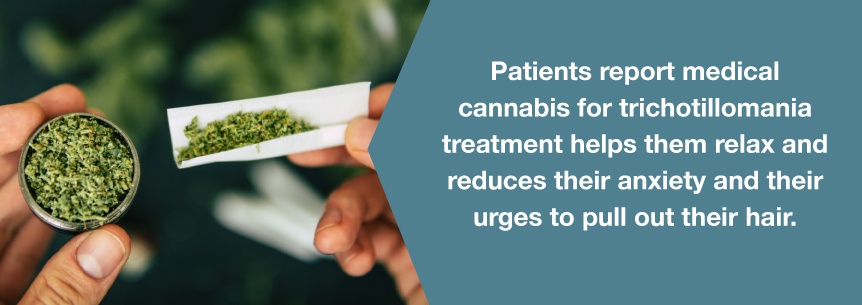
With neurochemistry, studies suggest trichotillomania may have an association with neurotransmitter overproduction, and THC may help moderate that. A 2011 study showed THC demonstrates substantial reductions in the symptoms of trichotillomania with no negative cognitive effects.
Even more evidence shows medical cannabis for trichotillomania treatment helps with emotional regulation. Hemp’s main psychoactive ingredient, THC, and the synthetic cannabinoid analogs either exacerbate or attenuate fear-related behaviors and anxiety in both experimental animals and humans.
In a study in the journal Fundamental & Clinical Pharmacology, investigating CBD and how it helps rats with obsessive-compulsive disorder, the team of researchers administered the psychoactive drug in ecstasy pills to rats. This drug is known for inducing panic attacks in people who are prone to them and makes OCD symptoms worse. It also inhibits SSRIs’ anti-compulsive effects.
Once the researchers administered the drug to the rats, they conducted a “marble-burying test” with them to investigate their OCD activity. Low doses of the drug increased the rats’ marble-burying tendencies. But, once the researchers injected the rats with low doses of CBD, they noticed it reduced the marble-burying behavior, but didn’t change the overall activity level of the rats. This suggests CBD has a potential anti-compulsive effect.
The typical treatments of trichotillomania in instances requiring medication are anti-depressants. Aside from these side-effect-laden medications, there are very few options for medication. The same goes for other impulse control disorders. There is some research into the use of medical marijuana and impulse control disorders that suggests it could provide relief from both the impulse and the cause.
Medical marijuana research has also delved into depression and anxiety. While research directly pertaining to trichotillomania is scant, research into the aforementioned areas of trichotillomania provide enough evidence to support pre-clinical and/or clinical testing on trichotillomania specifically.
One open clinical trial involved 14 women with trichotillomania, 12 of whom finished the trial. The authors of the study concluded treatment with dronabinol — a synthetic THC — significantly reduced the impulsive behavior of the subjects. However, they also noted the trial was open and there were few subjects. A larger blind, placebo-controlled study would provide more conclusive results.
The underlying cause for individuals with trichotillomania can differ between sufferers. Therefore, the medical marijuana treatment may differ. If the underlying cause is anxiety, sufferers will have to find a strain or a derivative that alleviates their anxiety, rather than increasing it. Studies have shown medical marijuana can have either effect. What treatment works best for trichotillomania-related anxiety will depend on the sufferer’s reaction to the medication.
There is a wealth of anecdotal and clinical research suggesting medical marijuana increases or even causes anxiety. However, the research is lacking on which components of marijuana appear to increase anxiety, and which appear to decrease it. That may be the secret to discovering why medical marijuana can both reduce and worsen anxiety. In the abovementioned clinical study, medical marijuana had a positive effect on trichotillomania. It would be helpful for future researchers to monitor anxiety, and for the study group to include some individuals with notable anxiety and trichotillomania.
According to a survey of 4,400 marijuana users, those who use marijuana experience fewer subjective symptoms of depression than those who do not. Medical marijuana could treat individuals with depression-induced trichotillomania. Even if the effects were purely subjective, which is unlikely, the relief and potential cessation of hair pulling would be real. In these cases, it is all about how a patient feels. Of course, placebo-controlled clinical trials would give more insight into whether medical marijuana treatment for depression can alleviate trichotillomania specifically.
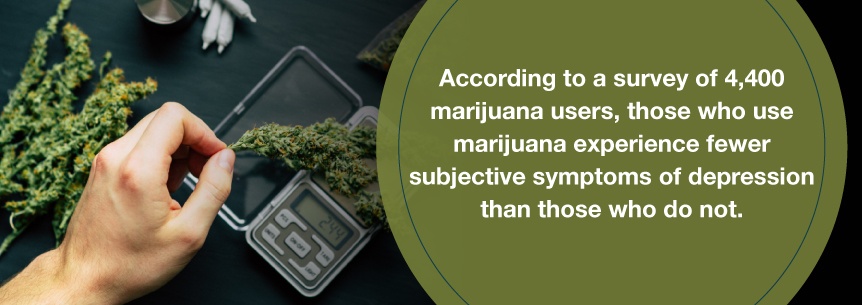
Looking for a relaxing cannabis and trichotillomania strain, but don’t want to experience the high? In some people, the THC can aggravate symptoms of anxiety. The good news is, there are strains rich in CBD with powerful anxiolytic properties. And, these CBD-rich strains don’t produce that mental, cloudy fog or paranoia you sometimes get with THC.
Some good anti-anxiety strains include:
CBD treatment helps reduce stressful, obsessive, compulsive and anxious tendencies.
Some high-CBD strains include:
Before trying any strains, you may want to consult with a qualified cannabis doctor or budtender who can steer you in the right direction. Some strains are more potent than others, and you’ll want to learn about the proper dosing as well.
You may want to try various marijuana for trichotillomania strains to see which ones will work best for your symptoms. Likewise, you’ll want to do the same thing with the different delivery methods of cannabis consumption.
Some delivery methods are better than others to relieve compulsive behaviors. For instance, you might not feel much by rubbing cannabis topically into your skin, but inhaling a vaporizer may do the trick. Some good delivery methods of your marijuana for trichotillomania treatment include:
The healthiest form of ingestion is probably adding some fresh marijuana leaves into your delicious smoothie. You’ll get all the nutrients of the plant and benefit from its medicinal properties as well.
To learn more about marijuana and trichotillomania treatment and see if you can relieve your hair-pulling urges, come on over to Marijuana Doctors. We have all the resources you need to educate you on your condition and the right cannabis strains and products.
We have a database full of qualified marijuana doctors and other helpful staff standing by to help you with your questions and concerns, and provide you with the consultation you need to get your recommendation for medical marijuana. Not only this, but you’ll stay up to date on the latest medical weed news and information by signing up to the MarijuanaDoctors.com newsletter. Set up your appointment today to get started.
Find A Doctor Find A Dispensary
Nobody knows exactly why individuals develop this disorder. Many believe stress plays a big role. Heredity and genes may as well. Individuals with OCD or other compulsive habits could be more at risk of developing trichotillomania.
Some experts believe the urge to pull hair occurs due to chemical signals in the brain not working properly, creating an overwhelming feeling of wanting to pull out hair.
Pulling hair provides the individual with a feeling of satisfaction or relief, and the more they give into the urge, the stronger of a habit it becomes. The longer a person continues this habit, the more difficult it becomes for them to resist the urge when it crops up again.
Trichotillomania sufferers have one of two types of the condition: compulsive or chronic. These people almost need to pull their hair from their eyebrows, eyelashes, scalp and other areas of their body.
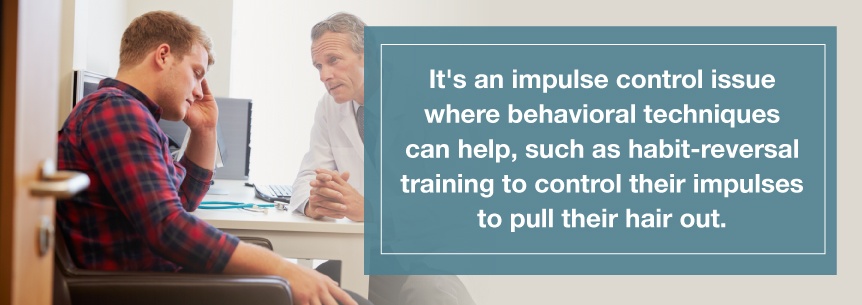
It’s an impulse control issue where behavioral techniques can help, such as habit-reversal training to control their impulses to pull their hair out. Short-term cognitive behavioral therapy, or CBT, is an ideal treatment for all trichotillomania patients.
For centuries, people have been observing the act of hair pulling. At certain times in history, the habit was acceptable and even encouraged in societies spanning the early Greeks, ancient Egyptians and the Jains in India. Today, the term trichotillomania specifically describes the abnormal act of pulling hair out due to a compulsive urge that arises in circumstances of anxiety and stress. The disorder is both fascinating and mysterious in both past and present.
Some symptoms of trichotillomania include:
For some individuals, the disorder is just an annoyance or a mild problem. For many others, however, embarrassment and shame about their hair pulling results in a lot of emotional distress and painful isolation. This places them at a higher risk for a co-occurring psychiatric condition like an anxiety or mood disorder. Pulling hair can result in strained relationships and tremendous tension. Members of the whole family may require professional help to cope with this issue.
Certain physical effects are common, such as:
Individuals who ingest the hair can develop a hairball, or a trichobezoar, in their stomach or intestines resulting in a gastrointestinal blockage and requiring surgical removal. While rare, trichobezoars are a serious risk to people who are ingesting hair.
According to a study published in Seminars in Cutaneous Medicine and Surgery, up to 4 percent of the overall population has trichotillomania. One percent, or 2.5 million, individuals in the U.S. will suffer from trichotillomania in their lifetime.
Trichotillomania studies are limited. However, some treatments have made it easier for individuals to decrease or entirely stop their hair pulling. Trichotillomania patients typically need help from behavioral and medical professionals to break their habit. Most individuals, with the right help, overcome their urges to pull hair. When they can stop, their hair typically grows back.
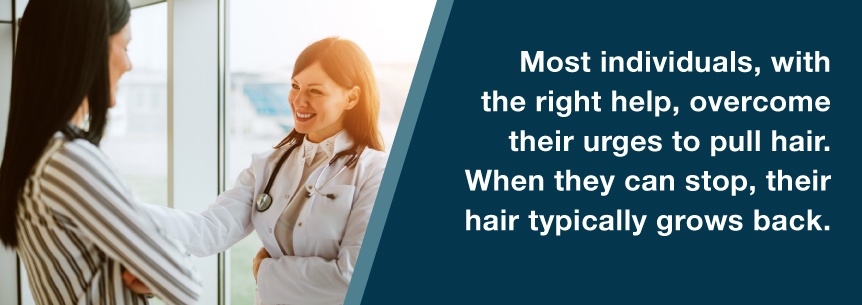
Several forms of therapy could help with trichotillomania.
Other therapies that help with mental health conditions linked with trichotillomania, like anxiety, depression or substance abuse, may prove an essential part of treatment. Therapy takes time and commitment for it to work.
While the FDA hasn’t approved any medications specifically to treat trichotillomania, there are some that could help with certain symptoms.
Your doctor may suggest an antidepressant, for instance. Side effects of antidepressants include:
Other medicines may include N-acetylcysteine, which is a neurotransmitter-influencing amino acid related to mood. Side effects may include:
It’s rare, but you could experience the following side effects:
When you breathe it in your lungs, it could cause mouth swelling, drowsiness, runny nose, chest tightness and clamminess.
Then there’s olanzapine, an atypical antipsychotic. Side effects include:
Discuss recommended medications with your doctor. You’ll want to measure the benefits as well as the side effects.
Although there’s limited research, more information is accumulating involving the impact, etiology and treatment of trichotillomania. Antidepressants and behavior therapy seem to help reduce hair-pulling symptoms effectively enough in trials. Improving behavior therapy with methods for addressing the emotional control tendencies of trichotillomania patients represents a promising direction in the treatment of this disorder.
Thorough and accurate assessment of the symptoms of this condition in both children and adults is important to both treating and understanding it. Health professionals use various assessment methods in treating the condition, which include the following.